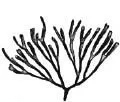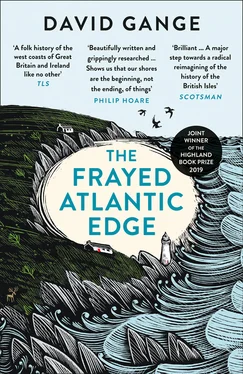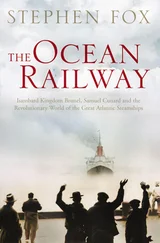By some kind of miracle, the calm weather in which I set out held for days, with only brief early-morning interludes of cloud and breeze. I was able to travel what should have been the most challenging stage of my journey with few hardships beyond some sunburn round the ears. The two rolls in the maelstrom round north Unst were my only submarine adventures. Covering an average of thirty-two miles a day – not as the crow flies, but in and out of gorgeous inlets with imposing headlands – I still had hours to read or hang around at sea when gannets dived or porpoise fins rolled above the waves. In the orange evenings and white mornings I stretched my legs across the islands I’d chosen to sleep on and nosed round their ruins (I’ve never been anywhere with so many abandoned buildings from so many centuries). I began to think up questions for present-day islanders and for the past Shetlanders whose lives persist in the archives. But this still idyll, I had to remind myself, could not last.

The sensible way to undertake a journey along Britain’s Atlantic coast would have been from south to north. With prevailing sou’westerlies at my back I would have been working with, rather than against, the weather. But I couldn’t bring myself to do that. While planning this trip in moments snatched from university teaching, familiar English and Welsh coastlines felt like the wrong kind of start. If I was to make sense of the Atlantic coastline, I had to begin by disorienting myself with total immersion in the seascapes and histories of a place I still knew mainly through clichés of longboats, horned helmets, sea mist and gales. This place is the seam between the Atlantic and North Sea, where waves rule Britannia and always have. It is a coast of staggering diversity as well as a thriving cultural hub: those coasts and that culture are thoroughly intermixed.
The bond between Shetlanders and their extraordinary tradition of small boats is rightly renowned. There are many Shetland dialect poems whose message boils down to the principle that a boat is more than a means of transport:
Take time; name dy boat weel,
fur du’s
naming a wye o life.
Du’s
naming a attitude. 6
Most families in nineteenth-century Shetland had a ‘fourareen’: a small, wooden vessel for inshore fishing and ferrying supplies (known as ‘flitting’). Shetland’s ‘national poet’, Thomas Alexander Robertson, who wrote under the name Vagaland, popularised an old Faroese proverb to sum up the ethos of this family vessel. This is now well known across Shetland:
Fragments of battered timber:
teak, larch, enduring oak,
but from them may be fashioned
keel, hassen, routh and stroke.
A homely vessel maybe,
we build as best we can,
to take us out of bondage:
bound is the boatless man.
Vagaland was born in 1909 in Westerwick, a tiny village on the Atlantic coast. Around this settlement are impressive drongs (the Shetland term for sea stacks). These are tall needles and prickly ridges, forming cauldrons in which the incoming Atlantic beats and swirls. Vagaland had reason to hate the sea: his father drowned here before young ‘Tammy Alex’ was a year old. But, like so many Shetlanders, he found poetry in boats, coasts, and rows or walks along the cliffs of the ‘wast’ side. Vagaland’s verse is full of evocations of small boats in driving gales on ‘da wastern waves’, of constellations reflected in still seas, and of rhythmic songs of sailors and fishermen.
Boats were essential to a family like Vagaland’s because Shetland life and laws necessitated coastal and inter-island links. An inhabitant of tiny Out Skerries, for instance, had rights to flay the peat from the more fertile island of Whalsay: like the people of most small islands, Skerries folk would regularly ‘flit da paet’. This didn’t just imply a single journey, but weeks of seasonal back-and-forth for cutting and turning to prepare the fuel for use. Provision boats, postal boats, fishing boats and social boats negotiated tidal channels in everything but the fiercest storms: many routes I took, between islets and along coasts, were once widely travelled in those ways.
Elegant Shetland-style boats now rest onshore in coves of the Atlantic coast, some in use and others in decay. But their distinctive form has a long and illustrious pedigree. The famous Gokstad ship, excavated in Norway and dated to AD 850, was accompanied by two small vessels that differ little from later Shetland examples. From the seventeenth to the nineteenth centuries, parts were bought from Norway to be pieced together on the islands. These Nordic kits made light, narrow and double-ended vessels. They ‘pranced’ on the water; their gunwales (the top edges of a boat’s sides) tapered before the bow and stern so the ship would flex and twist, dancing with the waves in ways that few boats can.
Yet each part of Shetland had different ocean-going needs, so the Shetland style developed local variations. From the beginning of the nineteenth century, three things accelerated this divergent evolution. First, the supply of Norwegian kits was interrupted by the Napoleonic Wars, giving Shetlanders new impetus to build for themselves. A generation later, the advent of steamers to the Scottish mainland allowed access to Scotland’s oak and larch, reducing the reliance of this treeless archipelago on Norwegian pine. Between these two changes, the need for vessels more suited to Atlantic conditions became horribly clear: in June 1832, thirty-one boats were wrecked in a sudden storm that lasted five days. A hundred and five fishermen drowned.
Soon there were boatbuilders all over Shetland, experimenting with styles suited to local waters. Of all the islands, Fair Isle – twenty-five miles south of Shetland mainland and twenty-four north of Orkney – maintained Norwegian design features such as the narrow beam and short gunwales most faithfully. Fair Isle craftsmen could rely on tides and isolation to bring enough drift- and wreck-wood to construct much of their yoals. The most specialised and distinctively shaped parts of the boat, however, had to be recycled from old boats into new ones. This explains why Fair Isle vessels were conservative in form.
In the rest of Atlantic Shetland, lightness was slowly sacrificed for ocean-going heft. Adaptation was modest in the south, and more dramatic in the north. At Sumburgh Head (the mainland’s southernmost headland) an extraordinary tidal splurge known as da roost provided excellent fishing, particularly for pollock (called piltocks by Shetlanders). Saithe boats stayed close to shore, but needed to hang on the edge of the tide, controlled by two skilled rowers, while two others ran lines through the racing sea. These boats were shallow and manoeuvrable; each could run da roost more than once a day.
A little further up the Atlantic coast, around the islands of East and West Burra, fishing grounds were sheltered, so there was no need for long, deep or beamy (wide) boats to carry large cargoes on heavy seas. Jetties were rare so boats were dragged up beaches to be kept in noosts (hollows in the ground). Short overland carries could help avoid tidal streams around these small islands and peninsulas. The result was that lightness remained a priority even as boats widened and lost their prancing flex.
The seafaring traditions further north were different. The demands placed on Unst boats grew rapidly after the Napoleonic Wars, partly because of the new confidence and abilities acquired by seamen returning from war, but also due to growing international demand for white fish which swam in grounds so far offshore that, in the words of an eighteenth-century commentator, distance ‘sink[s] the land’. Boatmen began to take the extravagant risks associated with travelling to the edge of the continental shelf and spending nights on the wild fishing grounds known as da haaf . With lines up to three miles long, bristling with a thousand hooks or more, they fished after rowing or sailing thirty to forty miles from home.
Читать дальше













